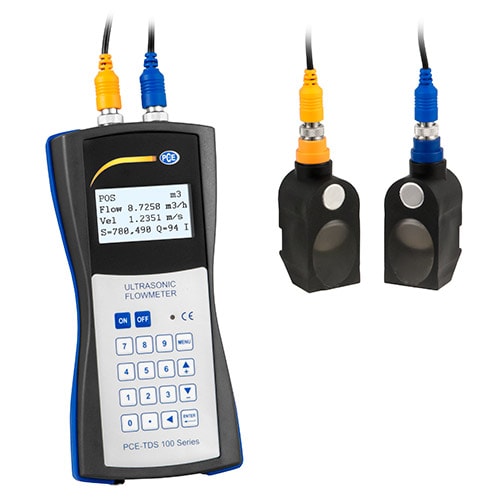Since the 1700s, scientists have been mesmerized by nature’s ability to use ultrasonic sound waves to navigate the terrain without the use of sight. Bats soared thru pitch-black caves and dolphins navigated the vast ocean using ultrasound while humanity still sailed by the stars in wooden ships. We have since harnessed the power of ultrasound and are still unlocking its potential.
Today we will look at the PCE-TDS 100H HVAC Meter, a product that harnesses this amazing technology and uses it to enhance HVAC technician’s ability to effectively troubleshoot industrial HVAC systems.

What is the PCE-TDS 100H HVAC Meter Good For?
An ultrasonic flow meter is used to gather information about a liquid being transported in an enclosed pipe or line. This is done by attaching ultrasonic transmitters and receivers to the outside of the pipe. Ultrasonic sound waves are emitted by the transmitter, through the material inside the pipe, and then received by the receiver.
Just as a bat can differentiate between the ultrasonic echoes in a dark cave to gauge the layout of the terrain ahead, the distortions in an ultrasonic sound wave can be automatically analyzed by the PCE-TDS 100H Ultrasonic HVAC meter to determine the flow, volume and other characteristics of the material inside an enclosed pipe or line. This meter is designed to be attached and operated quickly and easily, making it ideal for industrial HVAC applications.
Why an HVAC Tech Needs an Ultrasonic Flow Meter

An ultrasonic flow meter helps while troubleshooting or performing routine maintenance on chilled-water and cooling-tower units. These units are often found in commercial buildings. These types of systems operate by using the flow of water to transfer heat in and out of a structure. Common issues with these units can often be linked to a lack of flow. There are numerous flow switches in these systems that will shut off the unit if flow becomes too low.
An ultrasonic flow meter can help determine if the flow is in the correct range for these switches to operate. This allows the technician to quickly determine what the issue might be – a bad switch, another bad component, or some kind of obstruction somewhere in the system. An ultrasonic flow meter can save a technician hours in troubleshooting time by allowing a definitive diagnosis to be made quickly.
Who Else Needs an Ultrasonic Flow Meter?
The PCE-TDS 100H HVAC meter is ideal for use in oil and gas, water and wastewater, chemical, food and beverage, pharmaceutical, metals and mining, and pulp and paper applications.
Any industry utilizing enclosed pipes to transport a huge diversity of liquids is a suitable application for using the PCE-TDS 100H HVAC meter to check or monitor flow. Just a sample includes acetate, acetone, alcohol, ammonia, aniline, benzene, butyrate, chloroform, ethanol, ethyl alcohol, ethyl ether, ethylene glycol, freon R 12, petrol, glycerin, glycol, isobutanol, isobutane, isopentane, kerosene, linseed oil, methanol, methyl alcohol, engine oil, diesel oil, olive oil, peanut oil, paraffin oil, pentane, petroleum, 1-propanol, coolant, lubricating oil, silicone oil, transformer oil, trichlorethylene, 1, 1, 1 – trichloroethane, turpentine, distilled water, and/or sea water.
This unit’s easy setup and operation can be a smart alternative for smaller companies who do not have permanently-installed flow metering devices. Any individual or technician with the need to measure the flow of liquid in an enclosed pipe or tube will find the PCE-TDS 100H HVAC meter useful.
Review of the PCE-TDS 100H HVAC Meter
This meter measures flow velocity of liquids in enclosed piping and tubing. It is designed for quick and easy attachment for operation, making it ideal for industrial HVAC applications. The clamp-on style transducers allow for measurements to be taken without the enclosed system being compromised, while no contact is made with the liquid being measured.
PCE-TDS 100H

We may earn commission from purchases made from our links, at no additional cost to you
Features
- Bi-directional flow measurement
- Quick and adjustable response time
- Eliminates interfering frequencies
- Includes data logger functionality
- Stores up to 1800 measurement values
- Auto power-off battery-saving function (can be disabled)
- Saves time- and date-stamped measurement data to internal memory
- Factory-calibrated, rechargeable, battery-operated flow measuring device
- Includes 2-year warranty against manufacturer defects
Pros
Company website and contact information
Includes 2-year warranty against manufacturer defects
Meter comes with carrying case, and kit containing everything needed for use
User-friendly Velcro-strap clamps that allow for quick and easy installation and repositioning
In addition to the included user guide, company-sponsored online manuals, videos, and resources are available to help with meter set-up and operation
Cons
This meter is limited to transit-time method of ultrasonic flow metering
Conclusion
We have covered ultrasonic flow meter technology and its applications in HVAC and other industries. We hope our review of the PCE-TDS 100H HVAC Meter gave you a better idea of what this meter is capable of and helps you make an informed decision if you decide to purchase this item for use in HVAC or other applicable industries.
